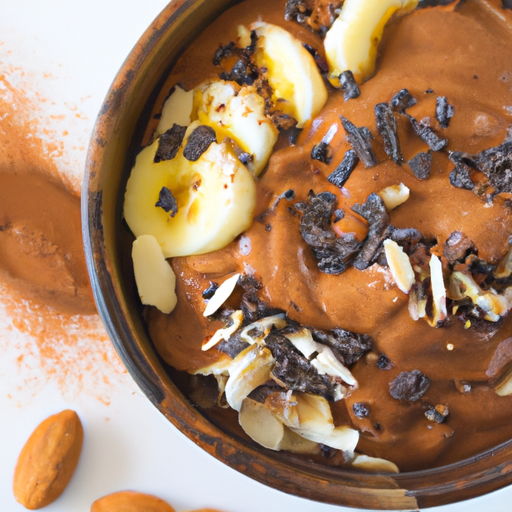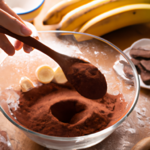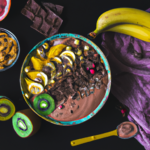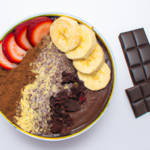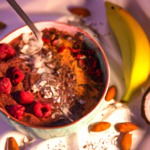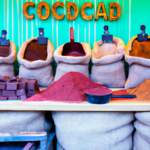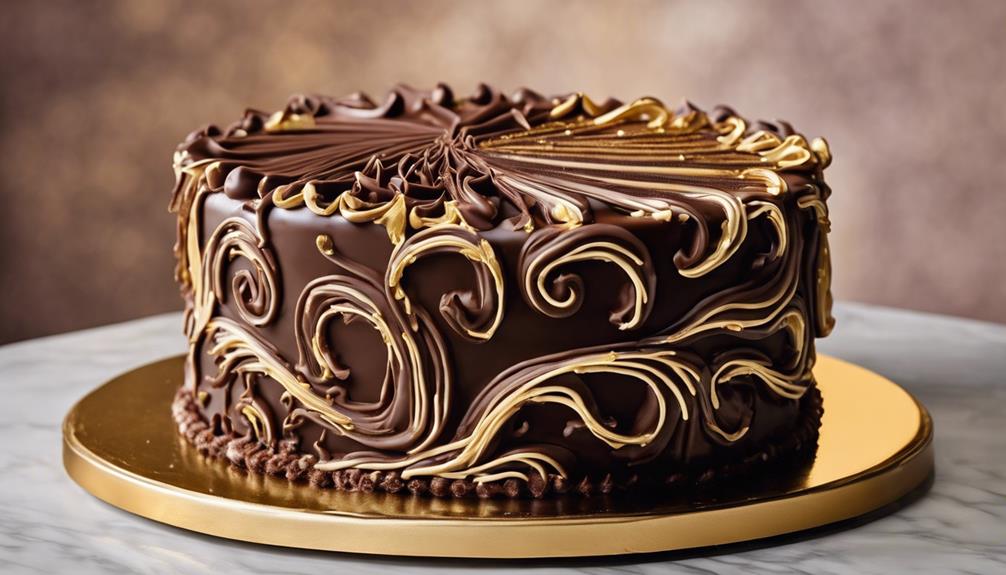Similar to a cozy embrace on a cold day, raw cacao powder has the ability to provide warmth and joy to any recipe. Whether in smoothies or baked treats, this adaptable ingredient imparts a decadent, chocolatey taste that is sure to please even the most selective dessert lover.
In this article, I will guide you through the wonderful world of consuming raw cacao powder, sharing tips and recipes along the way.
With its numerous health benefits, including being a great source of antioxidants and minerals, raw cacao powder is a guilt-free indulgence. Whether you’re looking to boost your morning smoothie, create a decadent dessert, or enhance your favorite hot beverage, this article has got you covered.
Get ready to explore a variety of ways to incorporate raw cacao powder into your everyday meals and treats. From creamy smoothies and luscious desserts to wholesome breakfast options and homemade salad dressings, you’ll discover endless possibilities to elevate your culinary creations.
So, grab your apron and let’s dive into the world of raw cacao powder together!
Key Takeaways
- Raw cacao powder can be used in a variety of recipes and dishes.
- Incorporating raw cacao powder into your diet adds a delicious and nutritious twist to meals and snacks.
- Cacao-infused nut butter spread can be enjoyed on toast, rice cakes, or whole grain bread with sliced bananas or strawberries.
- Creating cacao-infused salad dressings can enhance the flavor of greens and roasted vegetables.
Smoothies and Shakes
You can enhance the flavor and nutrition of your smoothies and shakes by adding a scoop of raw cacao powder. This will give them a rich and indulgent taste, making you feel like you’re sipping on a decadent chocolate treat.
Raw cacao powder is a great addition to any smoothie recipe. It adds a depth of flavor and a natural sweetness. Not only does it taste delicious, but it also offers numerous health benefits.
Raw cacao powder is packed with antioxidants, which can help protect your cells from damage. It is also a good source of magnesium, which plays a vital role in energy production and muscle function.
So next time you’re making a smoothie or shake, don’t forget to add a scoop of raw cacao powder for a delicious and nutritious boost.
Now let’s move on to hot beverages.
Hot Beverages
Create a rich and indulgent hot beverage by adding a small amount of this powerful ingredient. Hot chocolate made with raw cacao powder is a delicious and healthier alternative to processed cocoa mixes. Not only does it provide a deep, intense flavor, but it also offers numerous health benefits. The table below shows a comparison of the nutritional content of raw cacao powder, processed cocoa powder, and milk chocolate.
| Nutrient | Raw Cacao Powder | Processed Cocoa Powder | Milk Chocolate |
|---|---|---|---|
| Fiber | 4g | 2g | 1g |
| Iron | 2.2mg | 0.7mg | 0.9mg |
| Magnesium | 64mg | 27mg | 24mg |
To take your hot beverage to the next level, try adding a teaspoon of cacao powder to your morning coffee for a delicious cacao-infused pick-me-up. Now, let’s move on to the next section and explore how to incorporate cacao powder into delectable desserts.
Desserts
Indulge in a decadent treat by incorporating raw cacao powder into your favorite desserts. This powerful ingredient adds a touch of richness and depth to your sweet creations. Here are three ways to elevate your desserts using raw cacao powder:
-
Chocolate mousse: Whip up a velvety smooth chocolate mousse by blending raw cacao powder with avocado, dates, and a splash of almond milk. The result is a luscious, guilt-free dessert that satisfies your sweet tooth.
-
Raw brownies: Create fudgy, nutrient-packed brownies by combining raw cacao powder with dates, nuts, and a pinch of sea salt. These indulgent treats are not only delicious but also loaded with antioxidants and fiber.
-
Chocolate smoothie bowl: Make a refreshing and satisfying dessert by blending raw cacao powder with frozen bananas, almond milk, and a spoonful of nut butter. Top it off with your favorite fruits and granola for a healthy twist on a classic chocolate treat.
Now, let’s move on to the next section and explore how to incorporate raw cacao powder in baking.
Baking
Get ready to enhance your baking skills by incorporating the deep, rich flavors of raw cacao into your favorite recipes. Raw cacao powder is a great baking alternative to processed cocoa powder, as it retains more of its natural antioxidants and nutrients. Not only does it add a delicious depth of flavor to your baked goods, but it also provides numerous health benefits. Raw cacao is rich in magnesium, iron, and antioxidants, which can support heart health, improve mood, and boost energy levels.
To incorporate raw cacao powder into your baking, simply replace regular cocoa powder with an equal amount of raw cacao powder in your recipes. The table below shows some common baking ingredients and their raw cacao powder equivalents:
| Baking Ingredient | Raw Cacao Powder Equivalent |
|---|---|
| 1 tablespoon cocoa powder | 1 tablespoon raw cacao powder |
| 1/4 cup cocoa powder | 1/4 cup raw cacao powder |
| 1 cup cocoa powder | 1 cup raw cacao powder |
Now that you’ve learned how to use raw cacao powder in your baking, let’s explore some delicious breakfast options that incorporate this superfood.
Breakfast Options
When it comes to breakfast options, I love adding raw cacao powder for a chocolatey twist. It’s a simple and delicious way to elevate your oatmeal or cereal.
Another idea is to mix it into your pancake or waffle batter for a decadent and indulgent treat. Trust me, these breakfast ideas will satisfy your chocolate cravings and start your day off on a sweet note!
Add it to your oatmeal or cereal for a chocolatey twist
Sprinkle some raw cacao powder onto your morning oatmeal or cereal for a deliciously indulgent twist. It will make you feel like you’re enjoying a decadent chocolate treat. Not only does cacao powder add a rich, chocolatey flavor, but it also provides a boost of antioxidants and nutrients.
You can also mix cacao powder into yogurt for a creamy and satisfying snack. Or, add it to your coffee for a mocha-like experience. The possibilities are endless!
Next, let’s explore how to incorporate cacao powder into your pancake or waffle batter. This will create a delightful chocolatey twist to your morning stack.
Mix it into your pancake or waffle batter
Enhance your breakfast experience by blending the velvety essence of chocolate into your pancake or waffle batter with a touch of cacao powder. Not only will it add a rich chocolate flavor, but it will also provide you with a boost of antioxidants and essential minerals.
To incorporate cacao powder into your pancake or waffle batter, simply mix it into your pancake mix or waffle batter before cooking. The recommended ratio is about 2 tablespoons of cacao powder for every 1 cup of pancake mix or waffle batter. Stir the cacao powder into the dry ingredients until well combined, then proceed with the rest of the recipe as usual.
The result will be deliciously chocolatey pancakes or waffles that will satisfy your cravings and provide a nutritious start to your day.
Now, let’s move on to the next section and explore how to incorporate nut butters into your cacao powder creations.
Nut Butters
I love making my own cacao-infused nut butter spreads because they’re not only delicious but also packed with nutrients. It’s so easy to whip up a batch using raw cacao powder and your favorite nut butter.
I enjoy spreading it on toast or rice cakes for a satisfying and healthy breakfast or snack.
Make your own cacao-infused nut butter spreads
Transform your plain nut butter into a delectable indulgence by infusing it with the rich flavors of cacao powder. Not only does this add a touch of sweetness to your nut butter, but it also provides a boost of antioxidants and minerals.
Here’s how to make your own cacao-infused nut butter spreads:
-
Choose your nut butter: Whether it’s almond, cashew, or peanut butter, pick your favorite base to start with.
-
Add cacao powder: Mix in a tablespoon or two of raw cacao powder for every cup of nut butter. Adjust the amount based on your desired intensity of chocolate flavor.
-
Sweeten it up: If you prefer a sweeter spread, add a drizzle of honey or maple syrup to the mix.
-
Mix well: Stir or blend until the cacao powder is fully incorporated and the spread is smooth and creamy.
Once your cacao-infused nut butter spread is ready, use it as a topping for toast or rice cakes to add a delicious and nutritious twist to your breakfast or snack.
Use it as a topping for toast or rice cakes
Sprinkle your cacao-infused nut butter spread generously on top of your favorite toast or rice cakes for an irresistibly decadent and satisfying treat. Not only does it add a rich and creamy flavor, but it also provides a boost of nutrients.
For toast recipes, try spreading the cacao-infused nut butter on whole grain bread and topping it with sliced bananas or strawberries. The combination of the creamy spread and the sweet fruit creates a delicious and nutritious breakfast or snack option.
If you prefer rice cakes, spread the cacao-infused nut butter on top and add a sprinkle of shredded coconut or a drizzle of honey for added sweetness. The crispy texture of the rice cake pairs perfectly with the creamy cacao spread.
Now, let’s move on to the next topic: salad dressings.
Salad Dressings
I love experimenting with different salad dressings to elevate the flavors of my greens and vegetables.
One of my go-to combinations is mixing raw cacao powder with olive oil, balsamic vinegar, and other ingredients for a unique and flavorful dressing.
The rich and slightly bitter taste of the cacao powder adds depth to the dressing, while the olive oil and balsamic vinegar provide a smooth and tangy base.
I simply drizzle this delicious dressing over my favorite greens or roasted vegetables for a refreshing and nutritious meal.
Mix it with olive oil, balsamic vinegar, and other ingredients for a unique and flavorful dressing
Combine raw cacao powder with olive oil, balsamic vinegar, and other ingredients to create a dressing that will take your taste buds on a flavor-packed adventure. The combination of cacao with these ingredients creates a unique and delicious dressing that can elevate your salads to a whole new level.
Here’s how you can make it:
- Start by mixing 1 tablespoon of raw cacao powder with 2 tablespoons of olive oil in a bowl.
- Add 1 tablespoon of balsamic vinegar and whisk until well combined.
- For an extra kick of flavor, you can also add a pinch of salt and pepper, and a teaspoon of honey or maple syrup.
This cacao-infused dressing can be used as a marinade for meats or as a base for salad dressings. It adds a rich, chocolatey flavor that pairs well with both savory and sweet ingredients.
So go ahead, drizzle it over your favorite greens or roasted vegetables, and enjoy the delightful combination of flavors.
Drizzle it over your favorite greens or roasted vegetables
Drizzle this flavorful dressing over your favorite greens or roasted vegetables for a burst of unique and delicious flavors.
Raw cacao powder adds a rich and slightly bitter taste that complements the freshness of greens and the earthiness of roasted vegetables.
The dressing can be made by mixing raw cacao powder with olive oil, balsamic vinegar, and other ingredients. The result is a velvety smooth dressing that adds depth and complexity to your dishes.
Not only does it enhance the flavor of vegetables, but you can also drizzle it over grilled meats for a delightful twist.
Additionally, you can incorporate raw cacao powder into homemade ice cream for a decadent treat. The possibilities are endless with this versatile ingredient.
Now, let’s move on to exploring how to incorporate raw cacao powder into raw treats.
Raw Treats
When it comes to raw treats, there are so many delicious options to choose from.
One of my favorite ways to enjoy raw cacao powder is by making my own truffles or energy balls. They are easy to make and packed with nutrients.
Another great option is to create a cacao-based smoothie bowl or chia pudding. These are not only tasty but also provide a healthy and satisfying breakfast or snack.
Give them a try and indulge in the goodness of raw cacao!
Make your own raw cacao truffles or energy balls
To create your own delicious and nutritious raw cacao truffles or energy balls, gather the necessary ingredients and get ready to roll! Raw cacao is a fantastic ingredient that adds a rich and chocolatey flavor to your treats, while also providing numerous health benefits. It is packed with antioxidants, fiber, and minerals like magnesium and iron. By making your own raw cacao truffles or energy balls, you can control the ingredients and customize them to your taste preferences. Here is a simple recipe to get you started:
| Ingredients | Instructions |
|---|---|
| 1 cup raw cacao powder | In a bowl, mix all the ingredients together until well combined. |
| 1 cup dates, pitted | Roll the mixture into small balls or truffle shapes. |
| 1 cup nuts (such as almonds or walnuts) | Place the balls on a baking sheet lined with parchment paper. |
| 1/4 cup nut butter | Refrigerate for at least 30 minutes to firm up. |
| 1/4 cup honey or maple syrup | Enjoy your homemade raw cacao truffles or energy balls! |
Now that you’ve mastered the art of making raw cacao treats, let’s move on to creating a cacao-based smoothie bowl or chia pudding.
Create a cacao-based smoothie bowl or chia pudding
For a delicious and satisfying breakfast, you can create a cacao-based smoothie bowl or chia pudding. Cacao powder is a versatile ingredient that adds a rich and chocolatey flavor to any dish.
To make a cacao-based smoothie bowl, blend together frozen bananas, almond milk, cacao powder, and your choice of toppings such as sliced fruits, nuts, and shredded coconut. The result is a thick and creamy smoothie bowl that is both nutritious and indulgent.
Alternatively, you can make a chia pudding by combining chia seeds, almond milk, cacao powder, and a natural sweetener like maple syrup or honey. Let it sit in the fridge overnight to allow the chia seeds to absorb the liquid and become pudding-like. Serve with fresh fruits and a sprinkle of cacao powder for a satisfying breakfast or snack.
Now let’s move on to homemade drinks, where you can explore even more delicious ways to enjoy raw cacao powder.
Homemade Drinks
Ironically, whipping up your own homemade cacao-infused beverages can be a delightful way to indulge in the rich flavors of raw cacao powder. Not only are these homemade drinks a healthier alternative to store-bought sodas and sugary cocktails, but they also allow you to experiment with different flavor combinations and tailor them to your taste preferences.
Here are five delicious and refreshing homemade cacao-based drink ideas:
-
Cacao-infused almond milk: Blend raw cacao powder with almond milk for a creamy and nutritious beverage.
-
Cacao smoothie: Combine raw cacao powder, frozen bananas, almond milk, and a handful of spinach for a nutrient-packed smoothie.
-
Cacao-infused iced coffee: Add a tablespoon of raw cacao powder to your iced coffee for a mocha-like twist.
-
Cacao-infused water: Infuse water with raw cacao nibs for a subtle hint of chocolate flavor.
-
Cacao hot chocolate: Mix raw cacao powder with warm almond milk, a touch of sweetener, and a pinch of cinnamon for a comforting and indulgent treat.
With these homemade cacao-based drink options, you can enjoy the benefits of raw cacao powder in a refreshing and delicious way.
Frequently Asked Questions
Can raw cacao powder be used in savory dishes, such as soups or stews?
Yes, raw cacao powder can be used in savory dishes like soups or stews. It adds a rich, deep flavor and a hint of bitterness. Try experimenting with savory cacao recipes to enhance your main dishes.
Can raw cacao powder be used as a natural food coloring in recipes?
Yes, raw cacao powder can be used as a natural food coloring in recipes. It adds a rich, dark color and a slight chocolate flavor. It’s a great option for those looking to avoid artificial food colorings in their cooking.
How does raw cacao powder differ from regular cocoa powder?
Raw cacao powder differs from regular cocoa powder in terms of nutritional differences. Raw cacao is less processed, retaining more nutrients and antioxidants. It offers various health benefits and can be used in a variety of ways in cooking and baking.
Can raw cacao powder be used as a substitute for regular cocoa powder in baking recipes?
Yes, raw cacao powder can be used as a substitute for regular cocoa powder in baking recipes. It also adds a rich flavor when used in hot beverages and smoothies.
What are the health benefits of consuming raw cacao powder?
Consuming raw cacao powder offers numerous health benefits. It is rich in antioxidants, improves heart health, boosts mood, and enhances brain function. You can incorporate it into your diet by adding it to smoothies, oatmeal, or using it in baking recipes.
Are There Different Ways to Consume Raw Cacao Powder?
Yes, there are multiple ways of consuming raw cacao powder. You can mix it into smoothies, sprinkle it over oatmeal or yogurt, use it in baking, or make a hot chocolate drink. Each method offers unique eating raw cacao powder benefits and allows you to enjoy its rich flavor and health benefits.
Conclusion
In conclusion, incorporating raw cacao powder into your daily routine can be a delicious and nutritious way to enhance your meals and snacks. From smoothies and hot beverages to desserts and baking, the possibilities are endless.
By exploring these various options, you can indulge in the rich and decadent flavor of cacao while reaping its numerous health benefits. So go ahead, unleash your inner chocolatier and let the magic of raw cacao powder transform your culinary creations into pure bliss.
Enjoy the journey of discovering new ways to savor this heavenly ingredient!

